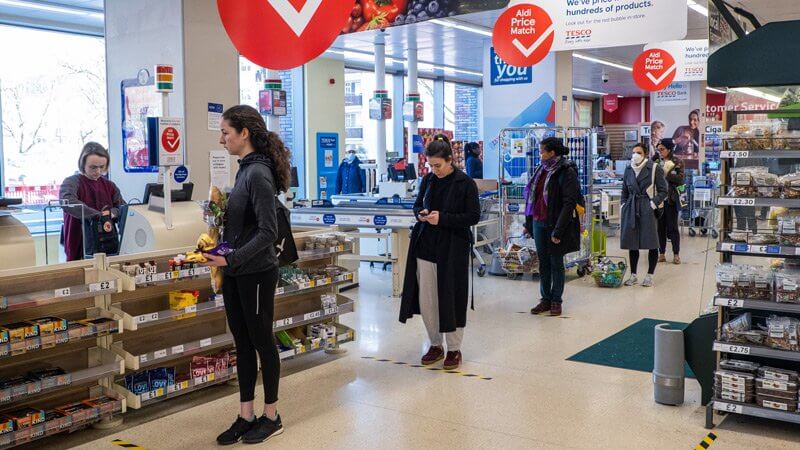The idea, as explained in a March article in The Atlantic, was to initially focus on protecting vulnerable groups — while other groups got sick (it was estimated that 60 percent of the population would need to be infected to achieve herd immunity):
But since the virus causes milder illness in younger age groups, most would recover and subsequently be immune to the virus. This “herd immunity” would reduce transmission in the event of a winter resurgence.
The nation has since backed off that plan. Though most infectious disease experts agree that the underlying concept may be key to reducing the dire threat represented by the virus that causes COVID-19.

The virus continues to spread worldwide and impact infrastructure while labs around the globe work tirelessly to search for a solution. COVID-19 is quickly becoming a part of society and it is having a significant impact on the daily lives of millions of people. For most, the virus will only result in mild symptoms,. But drastic measures are being taken to protect millions of patients with underlying health conditions that could be critically affected by the virus.
First identified in Wuhan, China, the virus is highly contagious and has triggered significant outbreaks across all continents, with the US, Spain, Italy and Germany being the worst affected outside Asia. Easy human-to-human transmission of COVID-19 has resulted in the declaration of a global pandemic for the virus which primarily affects the lungs of those infected. Symptoms are often flu-like with fever, cough and shortness of breath.
All things considered then, it is easy to look upon this crisis with despair. But there are places we can turn to for positivity. China has seen a dramatic reduction in new infections and just relaxed harsh restrictions in Wuhan. Additionally, human trials for a vaccine have started, pushing us another step forward in the fight against the virus. We are still likely at least 12 months from a fully licensed vaccine due to the rigorous testing that is required.
In the meantime, governments are seeking other methods to curb the spread of the virus in order to protect as many people as possible. The common theme includes closing of mass gatherings, restrictions on travel and the promotion of social distancing. Each country is implementing its own measures.
The UK’s initial approach was not well received by health experts. In an interview with BBC Radio 4, the UK’s chief science adviser stated that a key part of the coronavirus fight was to “build up some kind of herd immunity” in order to reduce disease transmission. This led to a backlash with the statement being seen as high risk, thus triggering a follow up press release stating “herd immunity is not our goal or policy, it’s a scientific concept”.
So what is herd immunity and why was this statement seen as worrying by many in the scientific community?
Herd immunity explained
Herd immunity is an indirect form of protection against infectious diseases. It occurs when a large percentage of a population becomes immune to a contagious illness. Viruses rely on person-to-person transmission in order to replicate and survive. Immunity in a large proportion of individuals minimizes virus transmission and eventually the virus dies out. In simple terms, we do not need 100% of the global population to become immune to COVID-19 in order to eradicate it. Current predictions suggest immunity in 60% of us would be sufficient. This is still a high number, however, and it is not something we should blindly push towards as the only strategy to deal with the current outbreak. There is the additional wildcard presented by the fact that researchers are unsure how long such immunity would last.

Appropriately handled
The resultant backlash surrounding recent comments on herd immunity focused largely on the loss in lives that could follow in the wake of 60% of the population being infected in short order. When we talk about herd immunity, we are mostly speaking within the context of diseases that can be vaccinated against. Large groups of people cannot receive vaccinations for medical or religious reasons and the same group are often the ones most vulnerable in disease outbreaks. In this situation herd immunity can be a very positive thing. Vaccinating enough people to stop disease spread can have the knock on effect of also protecting those who could not get vaccinated.
The big difference with COVID-19 is the fact that we do not have a working vaccine. In the absence of a widespread vaccination program, the only way we can reach herd immunity is by a large proportion of the global population falling ill. Whilst the current death rate is likely inflated due to a lack of cases being reported, some estimates still predict achieving 60% infection could result in up to 2.2 million deaths in the US alone. Arguably, this could be the cost we need to pay to protect the larger population. But it is critical we do everything we can to keep the death toll as low as possible in the fight against the virus. The price for pushing for rapid herd immunity would be simply too high.
Slowing the spread
In the absence of a vaccine, herd immunity may still represent one of our best hopes for battling the disease. But it is important for us to work together to get there in the most controlled way. If we have to rely on herd immunity, we must do so at a pace that allows our healthcare systems to cope as much as possible with the inevitable high demand. If we allow COVID-19 to spread without limitations, it will quickly overpower all forms of infrastructure.
As a result, the policies being put in place across the world are now focusing on social distancing and keeping people at home as much as possible. People over 70 are encouraged to restrict contact and we are being pushed to avoid all but essential travel. Doing so will allow us to flatten the curve of infection rates, buying us precious time to treat patients and test potential therapies. Promise has already been shown in repurposing many current drugs to treat COVID-19 symptoms and we are definitely seeing the benefits of a global research effort.
Our most powerful tool
Ultimately, our best weapon against the virus is time. The more time we can buy ourselves, the more we can develop effective strategies to fight the spread. Herd immunity can still play a pivotal role in eradicating the virus but it is something we need to achieve in a controlled manner. The take-home message is simple: Slow the spread, support our healthcare systems and protect the most vulnerable members of society. If herd immunity is eventually achieved, let it be on our terms and on a timescale that doesn’t cripple our global community. We will see the end of this pandemic and we should all focus on following the advice of healthcare authorities. This is not the end of the world but we have to take it very seriously for the sake of the millions of vulnerable people who need our support.
Sam Moxon has a PhD in regenerative medicine and is currently involved in dementia research. He is a freelance writer with an interest in the development of new technologies to diagnose and treat degenerative diseases. Follow him on Twitter @DrSamMoxon































